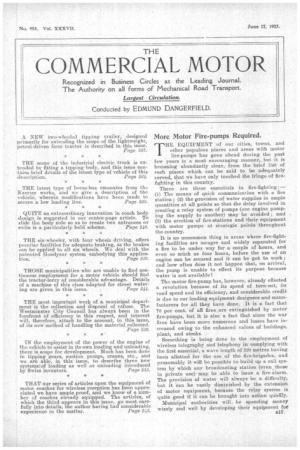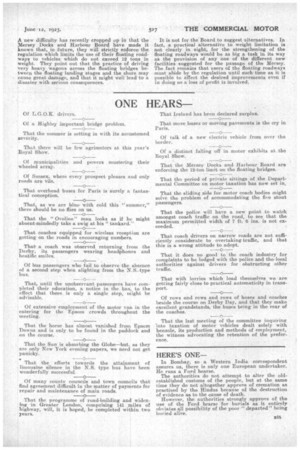More Motor Fire-pumps Required,
Page 1

Page 2

Page 3

If you've noticed an error in this article please click here to report it so we can fix it.
THE EQUIPMENT of our cities, towns, and other populous places and areas with motor fire-pumps has gone ahead during the past few years in a most encouraging manner, but it is becoming abundantly clear, from the brief list of such places which can be said to be Adequately served, that we have only touehed the fringe of firefighting in this country.
There are three essentials in fire-fighting :— (1) The means of quick communication with a fire station ; (2) the provision of water supplies in ample quantities at all points so that the delay involved in creating a relay system of pumps (one engine pumping the supply to another) may be avoided ; and (3) the erection of fire-stations and their equipment with motor pumps at strategic points throughout the country.
It is no uncommon thing in areas where fire-fighting facilities are meagre and widely separated for a fire to be under way for a couple of hours, and even so much as four hours, before the use of an engine can be secured and it can be got to work ; and how often does it not happen that, on arrival, the pump is unable to effect its purpose because water is not available?
The motor fire-pump has, however, already effected a revolution because of its speed of turn-out, its road speed and its efficiency, and considerable credit is due to our leading equipment designers and manufacturers for all they have done. It is a fact that 0 per cent, of all fires,are extinguished by motor fire-pumps, but it is also a fact that since the war fires have been more numerous and losses have increased owing to the enhanced values of buildings, plant, and stocks.
Something is being done in the employment of wireless telegraphy and telephony in. complying with the first essential, a wave length of 320 metres having been allotted for the use of the fire-brigades, and presumably it wild be possible to build up a call system by which any broadcasting station (even, those in private use)' may, be able to issue a fire-alarm. The provision of water will always be a difficulty, but it can be vastly diminished by the extension of motor equipment, because the relay system is quite good if it can be brought into action quickly.
Municipal authorities will., be spending money wisely and well by developing their equipment for
.
fire-fighting, and even the smallest municipal areas need not go without • suitable appliances now that the portable pump, which can be wheeled by hand or (hewn by any type of motor vehicle, is available. The motor turntable escape again has put a new appliance in the hands of fire-brigades for the rescue of imperilled lives from and for dealing with outbreaks in tall buildings
The Progress of Coach Design.
THERE IS a decided tendency in many quarters to look -upon the motor coach as having reached a stage of development at which it is difficult to forecast any further advance ; the modern vehicle, both as regards its chassis and body, is considered by some as the last word, and the opinion is freely expressed that what improvements can be embodied in the future will be mainly in details affecting the comfort of the passengers.
In our view, this is an entirely erroneous way of treating the matter, and we believe that very considerable differences indeed will obtain between the existing types of coaches and those of a few years hence. .
Progress in design is continuous, and many clever brains are scheming' developments which may have far-reaching effects. Such designers should be .afforded every, encouragement,, and we are always prepared to ventilate really valuable ideas in the columns of this journal so that their originators may be brought into more intimate touch with those who may be able to give' Chem assistance.
What appear to be revolutionary ideas do not always prove to be practicable, and for this reason perfectly sound schemes are often treated with scant attention. .
. To thosemanufacturers and designers who believe that the present types of coach body represent all that can be done with regard to ease of ingress and egress, the extremely novel body which we illustrate and describe elsewhere in this issue will prove rather a shock. The principle of allowing t a large section . of the side of a body to slide out; complete with steps at each -end, is not only novel, but appears to be quite a feasible proposition, and one which, if in practice it prove successful, may have a considerable influence on future coach design, and go a long way towards further popularizing the coaching movement amongst the general public: That such a startling innovation in body design can be suggested at this stage of coach development merely goes to prove that'we have.by no-means explored allthe avenues of:research which are available, and, if this be the ease with the body, how much more true may it not be of the chassis ?
Getting the Right Type of Bus for Traffic.
THE PROBLEM of suitable bus size is growing in many districts with the provision of the means of rapid passenger transit. As a nation, we are developing the " bus habit." We are no longer content, as-were our fathers and forefathers, to walk:for miles when business or duty.or social obligations compel us to fare afield. We wish to cut the time which the journey there and back would occupy, and to employ the time thus saved to better advantage. Fifty years-ago it was the general rule for workmen and men in business in London to walk from home to office or factory and hack again —sometimes a three or four-mile journey twice a day. In contrast therewith, we find men jumping on a bus in London streets to-day simply to save a walk of two hundred or three hundred yards ! It is not a matter, of laziness, but of impatience at the needless loss of time involved in walking the dis
tance. ...._ . So throughout the country bus services are' springing up and are definitely 'creating a new habit--that of riding. But the process is not taking the best course, because many of the vehicles now on the road are unsuitable for local conddions. In the Potteries trouble has arisen through the use by exservice men of small vehicles which the local authorities consider to be unsuitable for various reasons, and there is a tendency toafavour the larger types, because these give good service in the hands of the large operating concerns.
It is necessary for the authorities to move slowly in this matter, and not to allow themselves to be misled by what they see in the large towns and cities. For instance. the . experience gained in London, where!the•roads are suited to big vehicles, where traffic moves fast and the volume of passenger traffic is great, would be useless as a guide to the most suitable meanssof linking up towns in the Potteries.
By all means encourage the employment of reliable, comfortable, and well-equipped vehicles, but let the size of the vehicles be such as is suited to the width of the streets, the volume of vehicular traffic, and the character of the road surface. We believe firmly in the utility of the small-capacity bus (say, the 18-seater or 20-seater) on pneumatic tyres in certain areas, hut, as no hard and fast rule can be drawn, the local circumstances must in every case be carefully taken into account, and the best expert advice ' that is possible obtained before any general attempt _be made to exclude a certain type or 'size of vehicle, because in individual cases the vehicle appears to be unsuited to the work.
The Coming of the 12-ton Tipping Wagon.
IN OUR issue dated May 8th last we gave the first illustrated description of the new 12-ton Scamraell tipping wagon which was recently subjected successfully to a number of severe tests, including the climbing of Rickmansworth Hill with
a full load. ,
The mere carrying of such loads as this on a single vehicle—if such a tractor-lorry can be called—is quite a modern development, but the demonstrated fact that such loads can be discharged with ease in a few moments, either to the end ois sides of the vehicles, at once raises the value of such a vehicle to a very considerable degree.
For certain classes of work, such as road building and repairing, the ability to carry heavy loads for long distances and to discharge them at any required spot without the necessity for employing extra manual labour is of inestimable value, and opens up a new field of employment for the tractorlorry, which presents many potentialities in view of the ambitious road-building and constructing schemes which are either in operation or are contemplated for the near future. Hitherto, this type of vehicle has been placed at a serious disadvantage when it came to dealing with materials which could be handled far more expeditiously by the tipping wagon, and in producing the 12-ton tipper we feel that the manufacturers are meeting a demand which has made itself clearly apparent when it came to
• employing the tractor-lorry for other work than that of carrying ordinary goods. That the makers should have taken the bull by the horns and produced a three-way Upping vehicle is even more to their credit:
The Problem of Crossing the Mersey..
HE river Mersey co.nstitutes a barrier of peculiar difficulty in the matter of transport between Lancashire and the Wirral peninsula. It is too wide tosbridge, and there seems to be very little prospect of driving' a tunnel under it, although this latter should provide the best solution to the problem. The passage of the river by ferry naturally entails ranch delay, waits of anything from half an hour to a couple of hours before embarking being common.
A new difficulty has recently cropped up in that the Mersey Docks and Harbour Board have made it • known that, in future, they will strictly enforce the regulation which limits the use of their floating roadways to vehicles which do not exceed 12 tons in weight. They point out that the practice of driving -very heavy wagons across the floating bridges between the floating landing stages and the shore may cause great damage, awl that it might well lead to a disaster with serious consequences. It is not for the Board to suggest alternatives. In fact, a practical alternative to weight limitation is not clearly in sight, for the strengthening of the floating roadways would be as big a task in its way as the provision of any one of the different new facilities suggested for the passage of the Mersey. The .f act remains that users of the floating roadways must abide by the regulation until such time as it is possible to effect the desired improvements even if in doing so a loss of profit is involved.






























